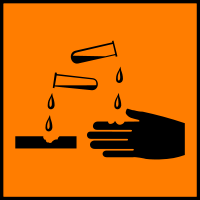|
Storage Condition
|
|
Room Temperature (15-30°C), Store Under Nitrogen
|
 Show
data source Show
data source
|
|
|
Storage Warning
|
|
Air Sensitive
|
 Show
data source Show
data source
|
|
|
RTECS
|
|
TX6825000
|
 Show
data source Show
data source
|
|
|
European Hazard Symbols
|
 Corrosive (C) Corrosive (C)
|
 Show
data source Show
data source
|
 Toxic (T) Toxic (T)
|
 Show
data source Show
data source
|
|
|
UN Number
|
|
2922
|
 Show
data source Show
data source
|
|
UN2734
|
 Show
data source Show
data source
|
|
|
MSDS Link
|
|
|
German water hazard class
|
|
2
|
 Show
data source Show
data source
|
|
|
Hazard Class
|
|
6.1
|
 Show
data source Show
data source
|
|
8
|
 Show
data source Show
data source
|
|
|
Packing Group
|
|
2
|
 Show
data source Show
data source
|
|
II
|
 Show
data source Show
data source
|
|
|
Australian Hazchem
|
|
2XE
|
 Show
data source Show
data source
|
|
|
Risk Statements
|
|
10-22-24-35
|
 Show
data source Show
data source
|
|
R:10-22-27-34
|
 Show
data source Show
data source
|
|
R:22-27-34
|
 Show
data source Show
data source
|
|
R10, R22, R24, R35
|
 Show
data source Show
data source
|
|
|
Safety Statements
|
|
26-36/37/39-45
|
 Show
data source Show
data source
|
|
S:27/28-29-36/37/39-45
|
 Show
data source Show
data source
|
|
S26, S36/37/39, S45
|
 Show
data source Show
data source
|
|
|
EU Classification
|
|
CT1
|
 Show
data source Show
data source
|
|
|
EU Hazard Identification Number
|
|
8B
|
 Show
data source Show
data source
|
|
|
Emergency Response Guidebook(ERG) Number
|
|
154
|
 Show
data source Show
data source
|
|
|
TSCA Listed
|
|
是
|
 Show
data source Show
data source
|
|
|
GHS Pictograms
|

|
 Show
data source Show
data source
|

|
 Show
data source Show
data source
|

|
 Show
data source Show
data source
|

|
 Show
data source Show
data source
|

|
 Show
data source Show
data source
|

|
 Show
data source Show
data source
|
|
|
GHS Signal Word
|
|
DANGER
|
 Show
data source Show
data source
|
|
Danger
|
 Show
data source Show
data source
|
|
|
LD50
|
|
177 mg kg-1 (dermal, rabbit)
|
 Show
data source Show
data source
|
|
700 mg kg-1 (oral, rat)
|
 Show
data source Show
data source
|
|
|
Explode Limits
|
|
15.2 %
|
 Show
data source Show
data source
|
|
2.8–15.2%
|
 Show
data source Show
data source
|
|
|
GHS Hazard statements
|
|
226, 302, 310, 314
|
 Show
data source Show
data source
|
|
H226-H302-H310-H314
|
 Show
data source Show
data source
|
|
H310-H302-H314-H318-H226
|
 Show
data source Show
data source
|
|
|
GHS Precautionary statements
|
|
280, 302+350, 305+351+338, 310
|
 Show
data source Show
data source
|
|
P280-P302 + P350-P305 + P351 + P338-P310
|
 Show
data source Show
data source
|
|
P280-P305+P351+P338-P309-P310
|
 Show
data source Show
data source
|
|
|
Personal Protective Equipment
|
|
Faceshields, full-face respirator (US), Gloves, Goggles, multi-purpose combination respirator cartridge (US), type ABEK (EN14387) respirator filter
|
 Show
data source Show
data source
|
|
|
RID/ADR
|
|
UN 2922 8/PG 2
|
 Show
data source Show
data source
|
|